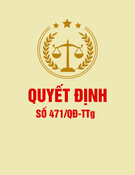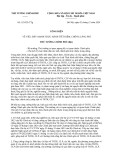PowerPoint Presentation prepared by Traven Reed Canadore College
Chapter 1 An Overview of Financial Management and the Financial Environment
Topics in Chapter
CH1
• Attributes of successful companies • Forms of business organization • Objective of the firm: maximize
wealth
• Determinants of fundamental value • Financial securities, financial
institutions, and financial markets
1-3
Copyright © 2011 by Nelson Education Ltd. All rights reserved.
Attributes of Successful Companies
CH1
• Like a stool needs all three legs to stand, a successful business relies on: – Skilled people – Strong external relationship – Sufficient capital
1-4
Copyright © 2011 by Nelson Education Ltd. All rights reserved.
The Corporate Life Cycle
CH1
• No two companies will develop in exactly
the same way
• A business usually begins as a small potato and hopefully finishes up as a major giant
• Structures of business organizations:
– Sole proprietorship – Partnership – Corporation Income trust –
1-5
Copyright © 2011 by Nelson Education Ltd. All rights reserved.
Starting as a Proprietorship
CH1
• Advantages:
– Ease of formation – Subject to few regulations – No corporate income taxes
• Disadvantages:
– Difficult to raise capital to support
growth
– Unlimited liability – Limited life span
1-6
Copyright © 2011 by Nelson Education Ltd. All rights reserved.
Starting as or Growing into a Partnership
CH1
• A partnership involves two or more entities with various privileges and responsibilities – General vs. limited partner – Limited liability partnership
• A partnership has roughly the same advantages and disadvantages as a sole proprietorship.
1-7
Copyright © 2011 by Nelson Education Ltd. All rights reserved.
Becoming a Corporation
CH1
• A corporation is a legal entity separate from its owners and managers.
• File papers and prepare reports
with Corporation Canada. – Articles of incorporation – Bylaws
1-8
Copyright © 2011 by Nelson Education Ltd. All rights reserved.
Advantages and Disadvantages of a Corporation
CH1
• Advantages: – Unlimited life – Easy transfer of ownership – Limited liability – Ease of raising capital
• Disadvantages: – Double taxation – Higher setup cost – Endless report filing
1-9
Copyright © 2011 by Nelson Education Ltd. All rights reserved.
A Unique Twist: Income Trusts
CH1
• Expand 100 times to a market capitalization of
$192 billion from 1994 to 2007
• Growth ends as government has announced
•
•
plans in 2006 to tax trusts at the same rate as corporations In the past, income trust cash distributions are only taxed in the hands of investors, not at the firm level Investors see trusts as tax-efficient and are willing to pay more for a company converted to a trust
1- 10 Copyright © 2011 by Nelson Education Ltd. All rights reserved.
What should be management’s primary objective?
CH1
• The primary objective should be
shareholder wealth maximization, which translates to maximizing the fundamental share price, not just the current market price.
• Should firms behave ethically? YES! • Business ethics are a company’s attitude
and conduct toward its employees, customers, community and shareholders
1- 11 Copyright © 2011 by Nelson Education Ltd. All rights reserved.
CH1
Stock Price Maximization and Social Welfare
• Do firms have any responsibilities
to society at large? Yes!
• Unethical behavior destroys public
trust and confidence.
• Maximizing share price is good for
society. Why?
• Shareholders are also members of
society.
1- 12 Copyright © 2011 by Nelson Education Ltd. All rights reserved.
CH1
Is Maximizing stock price good for consumers?
• Consumer welfare is higher in
capitalist free market economies than in communist or socialist economies due to competition
• Consumers can improve quality of life by the direct or the indirect investments in the stock market
1- 13 Copyright © 2011 by Nelson Education Ltd. All rights reserved.
Is maximizing stock price good for employees?
CH1
• Employment growth is higher in firms that try to maximize stock price. On average, employment goes up in: – firms that make managers into owners
(such as LBO firms)
– firms that were owned by the
government but that have been sold to private investors
1- 14 Copyright © 2011 by Nelson Education Ltd. All rights reserved.
How do managers affect shareholder wealth?
CH1
•
Improve a firm’s ability to generate cash flows now and in the future by focusing on: – Amount of expected cash flows
(bigger is better)
– Timing of the cash flow stream
(sooner is better)
– Risk of the cash flows (less risk is
better)
1- 15 Copyright © 2011 by Nelson Education Ltd. All rights reserved.
Free Cash Flows (FCF)
CH1
• There are many ways firms can
increase free cash flows
• FCF are cash flows available (or
free) for distribution to all investors (stockholders and creditors).
• FCF = sales revenues - operating costs - operating taxes - required investments in operating capital.
1- 16 Copyright © 2011 by Nelson Education Ltd. All rights reserved.
What is the weighted average cost of capital (WACC)?
CH1
• WACC is the average rate of return required by all of the company’s investors.
• WACC is affected by:
of debt and equity)
– Capital structure (the firm’s relative amounts
– Interest rates – Risk of the firm – Investors’ overall attitude toward risk
1- 17 Copyright © 2011 by Nelson Education Ltd. All rights reserved.
Determinants of a Firm’s Value
CH1
1- 18 Copyright © 2011 by Nelson Education Ltd. All rights reserved.
Who are the providers (savers) and users (borrowers) of capital?
CH1
• Households: Net savers • Non-financial corporations: Net
users (borrowers)
• Governments: Net borrowers • Financial corporations: Slightly net borrowers, but almost breakeven
1- 19 Copyright © 2011 by Nelson Education Ltd. All rights reserved.
Capital Allocation Process
CH1
1- 20 Copyright © 2011 by Nelson Education Ltd. All rights reserved.
Transfer of Capital from Savers to Borrowers
CH1
• Direct transfer (e.g., corporation issues
•
•
commercial paper to insurance company) Indirect transfer through an investment banker (e.g., IPO, seasoned equity offering, or debt placement) Indirect transfer through a financial intermediary (e.g., individual deposits money in bank, bank loans to a firm)
1- 21 Copyright © 2011 by Nelson Education Ltd. All rights reserved.
Cost of Money
CH1
• Supply and demand of funds determine the price of money.
• What do we call the price (or cost) of debt capital? Of equity capital? – Interest rate – Cost of equity = required return = dividend
yield + capital gain
• Both are the rate fund users pay to
fund providers
1- 22 Copyright © 2011 by Nelson Education Ltd. All rights reserved.
What four fundamental factors affect the cost of money?
CH1
• Production opportunities • Time preferences for consumption • Risk • Expected inflation
1- 23 Copyright © 2011 by Nelson Education Ltd. All rights reserved.
What economic conditions affect the cost of money?
CH1
• Bank of Canada policies • Budget deficits/surpluses • Level of business activity (recession or
•
boom) International trade deficits/surpluses
• Country risk depending on its economic,
political, and social environment
• Exchange rate risk
1- 24 Copyright © 2011 by Nelson Education Ltd. All rights reserved.
Financial Securities
CH1
• Financial securities are contracts
granting owners specific rights and claims on specific values • Vary in risk and maturity • Nature of claims: debt, equity, and
derivatives
• Money market instrument (T<1),
and capital market instrument (T≥1)
1- 25 Copyright © 2011 by Nelson Education Ltd. All rights reserved.
Financial Securities
CH1
Debt
Equity
Derivatives
Money Market
•Options •Futures •Forward contract •T-Bills •Banker’s Acceptances •Commercial papers •MMMFs •EuroCanadian dollars
Capital Market
•Canadian Government-Bonds •Mortgages •Corporate bonds
•Common stock •Preferred stock •LEAPS •Swaps
1- 26 Copyright © 2011 by Nelson Education Ltd. All rights reserved.
Typical Rates of Return
CH1
Instrument
Rate (April 2009)
Gov’t of Canada T-bills
2.05%
Banker’s acceptances
3.57
Commercial paper
5.39
Money Market mutual funds
3.50
EuroCanadian market time
3.45
Commercial loans:
Tied to prime
5.25 +
or LIBOR
3.05 +
1- 27 Copyright © 2011 by Nelson Education Ltd. All rights reserved.
Typical Rates (cont’d)
CH1
Instrument
Rate (April 2009)
Gov’t of Canada bonds
3.56%
Mortgages
6.50
Corporate bonds
5.11
Leases
5.11
Common Stock
10.9
1- 28 Copyright © 2011 by Nelson Education Ltd. All rights reserved.
What are some financial institutions?
CH1
•
Investment banks • Commercial banks • Trust companies • Credit unions • Life insurance companies • Mutual funds
– Money Market Funds (MMMFs) – Exchanged Traded Funds (ETFs)
• Pension funds • Hedge funds
1- 29 Copyright © 2011 by Nelson Education Ltd. All rights reserved.
Types of Financial Markets
CH1
• A financial market brings together
savers and borrowers.
• Physical asset vs. financial asset
markets
• Spot versus future markets • Money versus capital markets • Primary versus secondary markets • Private versus public markets
1- 30 Copyright © 2011 by Nelson Education Ltd. All rights reserved.
CH1
Physical- vs. Financial-asset Markets
• Physical (a.k.a. tangible or real)
asset markets – Products as wheat, autos and real
estates
• Financial asset markets
– Primitive securities and derivative
securities
1- 31 Copyright © 2011 by Nelson Education Ltd. All rights reserved.
Spot vs. Futures Markets
CH1
• Spot (a.k.a. cash) markets
– Assets are bought or sold for “on-the-
spot” delivery • Futures markets
– Assets are bought or sold for delivery
at some future date
1- 32 Copyright © 2011 by Nelson Education Ltd. All rights reserved.
Primary vs. Secondary Markets
CH1
• Primary
– New issue (IPO or seasoned) – Key factor: issuer receives the
proceeds from the sale.
• Secondary
– Existing owner sells to another party. – Issuing firm doesn’t receive proceeds
and is not directly involved.
1- 33 Copyright © 2011 by Nelson Education Ltd. All rights reserved.
Private vs. Public Markets
CH1
• Private markets
– Transactions are worked out directly
between two parties
– Lack of liquidity • Public markets
– Standardized contracts are traded on
an organized
– More liquid and transparent
1- 34 Copyright © 2011 by Nelson Education Ltd. All rights reserved.




































